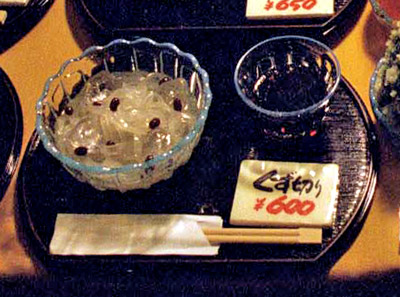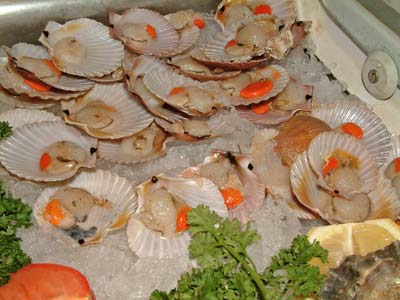
Water shield. A plant with deep maroon flowers that grows on the bottom of deep, clear old ponds. In late spring its immature buds are surrounded by a gelatinous sheath. Junsai is texture food, both rare and difficult to obtain. It's best season in Japan is June but it is available from April to September. At a kaiseki meal in Kyoto, this was our first course (of nine). We thought it was raw frogspawn, but anyway found the flavour delicate and delightful, and the texture fine, sliding down the throat. They actually do grow in Europe and North America in similar waters but it is not generally eaten in these cultures.
Fishwort. A green leafy plant with a slightly fishy smell used in China, Japan, Korea and South East Asia. The roots may also be used and the plant is also used for medicinal purposes.
Kabosu is a juicy green citrus fruit with the sharpness of lemon, used instead of vinegar in some Japanese dishes.

The eye of the scallop or the adductor muscle of the giant clam, dealt with like scallops but more tender and sweeter.
Kaiseki is perhaps the most refined and exquisite branch of Japanese cooking. It is the formal Japanese haute cuisine, served in nine courses or more on antique ceramics and lacquer ware. It is designed to appeal to all the senses and uses only seasonal ingredients. Unlike chakaiseki, or tea-ceremony kaiseki, restaurant-style kaiseki cuisine originated in the meals served at poetry gatherings. (This explains why restaurant-style kaiseki is usually written with Chinese characters meaning "banquet.") Today, this type of cooking can be found at first-class Japanese restaurants, where guests can enjoy eating in a relaxed, informal setting. In restaurant-style kaiseki, courses are served on lacquered trays without legs and are enjoyed one at a time. The menu generally consists of a sakizuki (appetiser), a suimono (clear soup), a mukozuke (usually slices of raw fish), a kuchigawari (palette refresher), a yakimono (something grilled), a nimono (something boiled or simmered), an aizakana (something steamed or deep-fried), a sunomono (something vinegared) and a tomewan (final dish). On the simplest level a kaiseki course consists of one soup and three side dishes (rice and pickles are included but are not numbered among the dishes.) Courses increase in complexity in odd increments to include arrangements of five dishes (two of which are soup), seven, nine, eleven, etc. Their contents and the order in which they are served is left up to the chef's discretion. Aemono are highly decorative salads designed to complement any of these courses.